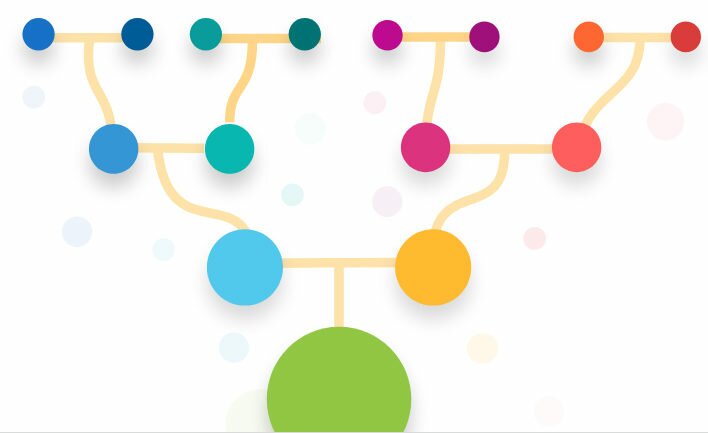Double cousins occur when two siblings from one family have children with two siblings from another. The two sets of offspring will be genetically related through both of their parents and will share twice as much DNA with each other compared to regular first cousins.
A double cousin essentially means that you and your cousin share 25% of your DNA makeup with each other. This is the same quantity that you would share with a half-sibling, an aunt or uncle, and a grandparent.

It is twice the amount of DNA that first cousins would normally share, hence the name “double cousin”. This tends to be found in the children of pairs of siblings that marry one another.
Shared DNA Between Different Relationships
Identical twins are made when one fertilized egg splits into two. This is known as monozygotic twins and both will share 100% of the same DNA makeup.
Full siblings are children born from the same set of parents. These people will share, on average, 50% of their DNA.
Half siblings share one of the same parents, whether this is the mother or father. Half siblings will share 25% of their DNA profile.
Double first cousins, as mentioned above, will share 25% of their DNA.
First cousins are related via a grandparent, or set of grandparents. They tend to be your aunt or uncle’s children and you will share around 12.5% of their DNA.
First cousins once removed are the parents or children of your first cousin. You still share DNA with them, but only around 6.25%.
Parents and their children will share 50% of their genetic makeup. Grandparents and grandchildren share 25%, as do aunts or uncles with their nephews or nieces.
Great-grandparents and their great-grandchildren will share an average of around 12.5% of their DNA profile. Half first cousins share 6.25% as do double second cousins.
A half first cousin is someone that you share one grandparent with. This may be because your parents are half-siblings. Second cousins have parents who are first cousins and their grandparents are siblings.
A double second cousin can occur in 2 separate ways. The first is if two sets of first cousins have relationships with each other. You can also get double second cousins if two double first cousins have kids with people. Their offspring would then be classified as double second cousins.
So How Do The DNA Sequences Work in Double Cousins?
To understand this, you must first have a good grasp of how individual DNA is created. You will get 50% of your DNA from your mom, and the other from your dad.
This is true for every human being, so your parents will have a mix of both their parent’s DNA. In the way we are detailing this here, you will not be able to distinguish between two siblings from the same parent set.
Of course, in reality, this is not the case as different parts of each parent’s DNA will be given to different children. As the two sets of DNA from your parents overlap to form a child, we say that you will share an average of around 50% DNA with your siblings.
Now, this is very simplistic. In the human body, DNA is stored in pairs of chromosomes. The standard number of chromosome pairs is 23. There are some genetic conditions, such as Downs Syndrome which are caused by an extra chromosome.
So let’s look again at our two families, drawing their DNA profiles as pairs of chromosomes now. We are only going to draw one pair, but the same logic applies to all of them.
Mom Dad Child
In reality, the DNA does not split up as nicely as this into such organized sections. Every child will get one chromosome from their mother, and one from their father. This is depicted by the four different colors.
The two chromosomes from the mother merge together to create one chromosome in the child. This means that they are not exact copies and this process is known as recombination. The same principle applies to the father’s DNA.
Each child that the parental set has will have a slightly different DNA sequence. They will still share 50% of the same DNA, but it will not be the same 50%. Below is a diagram of this idea.
Sister 1 Sister 2
If we put the two female and two male chromosomes together, we can see the 50% DNA the siblings share.
As we mentioned earlier, for double cousins to form you need to have 2 sets of siblings reproducing with each other.
First set of siblings (sisters) Second set of siblings (brothers)
If we pair the siblings off, we begin to see the structure of the two families.
Family 1 Family 2
If these two families then have children, their child’s genetic makeup will be a combination of all 4 colors.
Family1 Family2
You Cousin
If we take the maternal strands of each pair and compare them, we begin to see shared DNA patterns. The same applies to the paternal DNA strands. We have put boxes to indicate the shared DNA.
Y C Y C
While on these pairs of DNA it appears as though you and your cousin share more than 25% DNA, it will even itself out across all of the other pairs contained within the body.
Can You Marry Your Double Cousin?
The rules on marrying your cousin vary from state to state. In all states you are legally allowed to marry your second cousin. In some states marrying your first cousin is illegal and others carry different qualifying characteristics.
In 19 states there are no restrictions on marrying first cousins. North Carolina is the only state to explicitly ban the marriage between double first cousins.
Some states will allow marriages between first cousins if there is no possibility of offspring. This may be due to age, or a medical condition that prevents fertility. This is the case in 6 states: Wisconsin, Utah, Maine, Indiana, Illinois, and Arizona.
Louisiana does not allow first cousins to marry, and so does Minnesota. The exception to this is if the aboriginal culture of the couple from Minnesota permits marriage between cousins.
Adopted cousins can marry in Mississippi, Oregon, and West Virginia. Half cousins can marry in 6 states where full cousins cannot: Oklahoma, Nebraska, Nevada, Montana, Kansas, and Arizona.
What Does The Bible Say About Marrying Your Cousin?
There is nothing written in the Bible that explicitly prevents you from marrying your cousin. There are many passages in Leviticus that speak against having any kind of sexual contact with an immediate family member. These include parents, grandparents, aunts and uncles. Nothing is explicitly mentioned about cousins.
There are examples of cousin marriages in biblical Scripture. One such example is Genesis where Jacob is commanded by Isaac to marry is cousin Rachel. He later married his cousin Leah too.
What Will Happen If You Have a Baby With Your Cousin?
HAving children with people you are related to is generally seen as a taboo due to the increased risk of birth defects in the resulting child. Non-related couples have a roughly 2-3% chance of their baby developing congenital disabilities. For children of first cousins, this risk doubles to 4-6%.
This is not a huge increase in likelihood, however it is a very real risk. If you are married to someone that is related to you, it is wise to seek out genetic counselling and advice before you attempt to conceive.
Can You Marry Your Half Sibling?
As you share the same quantity of your DNA with a half sibling as you do a double first cousin, surely the laws should be the same.
This is not the case however. In all states in America siblings are forbidden to marry, whether they are half- or full.
In New Jersey and Rhode Island you are not permitted to marry your siblings, but it is not illegal for you to enjoy a sexual relationship with them. This is of course, providing they are consenting adults.
